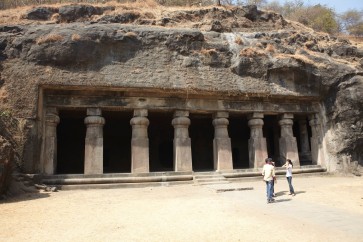Shiva Cave Travel Map
The main cave is also known as Shiva Cave. It spans an area of 27 sq m and is inclusive of a hall or Mandapa. At the entrance, there are four doors with an aisle at the back and three open porticoes. There are six pillars in each row that divide the hall into a series of smaller chambers. The roof of the hall comprises concealed beams supported by stone columns joined together by capitals. The entrance of the cave is aligned with the north-south axis. It is unusual for a Shiva shrine that normally is aligned with the east-west axis.The northern entrance to the cave comprises 1000 steep steps flanked by two Shiva panels, which dates back to the Gupta period. While the right panel depicts 'Nataraja', Shiva as the Lord of the Dance; the left panel depicts 'Yogishvara', the Lord of Yoga. In the right section of the main hall, the central Shiva shrine is situated. The central shrine is a free-standing square cell with four entrances. At the west and east ends of the caves, smaller shrines are located and the eastern sanctuary serves as a ceremonial entrance.The walls of the cave have large carvings of Shiva, each of which is of a height of 16 ft. On the southern wall, there is a central carving of Shiva called 'Trimurti'. The carving is flanked by 'Gangadhara' to its right that denotes the descent of River Ganges from the matted locks of Shiva. The left is flanked by 'Ardhanarisvara', which is a half-woman, half-man representation of Shiva and Parvathi. In the main hall, other carvings related to the legend of Shiva are placed in strategic locations in exclusive cubicles. These carvings include 'Shiva-Parvathi' on Mount Kailash, the abode of Shiva; 'Andhakasuravadamurti' or 'Andhakasuramardana', the slaying of the demon Andhaka by Shiva; 'Kalyanasundaramurti', depicting Shiva's marriage to Goddess Parvathi and 'Ravananugraha', depicting the demon-king Ravana shaking Kailash.The main cave combines the architectural features of the Chalukyan Empire like the square pillars with custom capitals and massive figures of guardians and divinities with the artistic characteristics of the Gupta period such as the depiction of clouds, mountains and female hairstyles. The East Wing shrine comprises carvings of 'Kartikeya', 'Ganesha', 'Matrikas' and 'Dvarapala' and the West Wing shrine is inclusive of sculptures of 'Nataraja' and 'Yogishvara'.
Other Places To Visit In Elephanta Caves
Gharapuri, Maharashtra 400094, India

